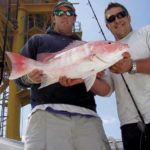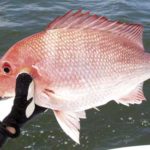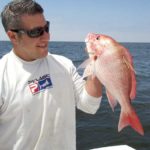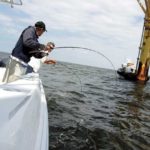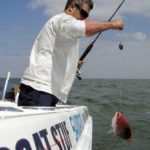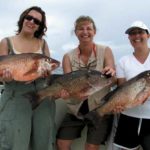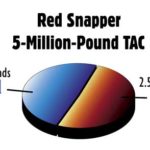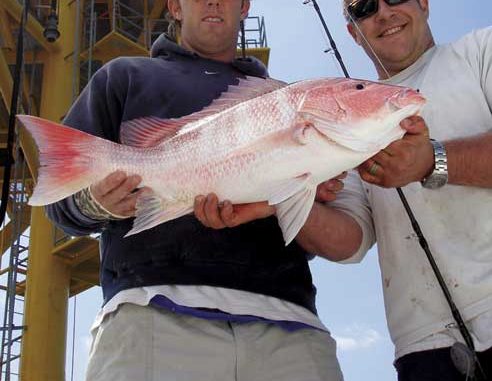
The fish are swarming offshore, but with cinched-up limits, most of them are there just to tease anglers.
Capt. Kerry Milano eased his sleek 34 Contender up to the rig as his deckhand, Eddie Cerise, Jr., readied the rig hook. With a quick toss, we were securely attached to one of the many platforms that dot the map in the West Delta fields south of Venice. No sooner did the boat come to rest alongside the rig and each of us drop a piece of cut pogie to the bottom than three fat red snapper were hauled aboard.
“I don’t dare drop a double rig,” joked Milano as he hoisted the 6-pound snapper over the gunwale.
“I’m switching over to light tackle for my second snapper,” said Milano, as he grabbed a Challenger spinning rod outfitted with a Shimano Stradic reel spooled with 30-pound PowerPro.
Instead of the usual heavy sinker and Carolina rig, we opted for single Mustad 6/0 weighted hooks with cut pogies. The only problem with this set up was that the snapper inhaled the offering — hook and all — which made releasing them difficult.
When the bait hit the bottom, Milano reeled up a crank or two and held on as the rod bucked and bent double.
“Now THIS is the way to fight a red snapper! he said.
With the new regulations in place limiting recreational anglers to a two-fish bag limit and an abbreviated two-month season, this summer will test the nerves of those who love this tasty, ruby-scaled fish.
Gone also are the days when charter captains and crew could keep their limits during a trip.
Milano, like most other captains across the coast, has planned to make adjustments to the way he currently runs his trips.
“I am going to do an add-on for each trip; for example, we’ll start out live-baiting for tuna, fish till about two o’clock and then head in to shallow water and add a limit of amberjack and pick up our red snapper,” he said.
For those customers who prefer rig fishing over targeting tuna, Milano says he will go after mangrove snapper, grouper and other bottom species.
“I think the season that we are going to have is going to be phenomenal based on what we have seen when pre-fishing and releasing snapper,” Milano said.
As the water warms, the fish will move to deeper water.
Small boat anglers may want to take advantage of the high river and the cold water flowing out, which may entice the snapper to stay in closer for a longer period of time.
The consensus is that there will be a lot of culling since the limit is two snapper per person with no captain/crew limit.
There will be more pressure on the tuna fishery as those larger boats are slow, which will force them to do overnight tuna trips. With more boats pounding them at night, it will definitely have an impact on other fisheries.
“One solution is that the shrimpers could be moved out to the 50- or 100-fathom curve to reduce the mortality on juvenile snapper,” said Milano.
Capt. Myron Fischer on the 53-foot Hatteras Different Drummer says the new limits will affect all charterboats. Fischer, who has been a skipper for more than 30 years, has seen changes in the past, but the snapper limitations that have been implemented will certainly result in some losing their livelihoods.
“Those who depend on bottom fishing primarily, such as the larger head boats, will immediately feel the adverse affects, while those of us who fish offshore pelagics will only hear about the pinch,” said Fischer, who serves on numerous fisheries committees.
“With that being said, there is still a direct relationship with the season length and bag limit of snapper and how it affects the phone ringing for charters.”
Fischer says in his case, snapper is a back-up species, while the bluewater fish are primarily his target species.
“Sharp bottom fishermen will target amberjack, vermillion, triggerfish, grouper and mangrove snapper, and use the red snapper bag as a bycatch limit,” said Fischer. “Then at the end of the day, they can intentionally fish red snapper to finish off the limits.”
During March and April, Fischer attended a three-day red snapper meeting in Mobile, Ala., a two-day reef fish meeting in Tampa, four days at the Gulf Council meeting in Baton Rouge and ended five weeks of travel with four days in Washington at a Highly Migratory Species meeting.
In Baton Rouge, he said interested parties got a rare chance to sit down face-to-face with Dr. Roy Crabtree, regional director of the National Marine Fisheries Service. Crabtree explained to the attendees what brought us into the drastic situation we are in with the low bag limit and short season.
He also dispelled many rumors and myths that have been floating about the docks concerning his duties, limitations, etc.
Capt. Tommy Pellegrin, who operates the Reel Life, a 36-foot Gravois out of Cocodrie, has been nicknamed the “Snapper Master” by his customers. Pellegrin says he will now redirect his efforts to target other species.
“The new limits will hurt us the most on rough days when you can only get to the close rigs,” he said. “Red snapper were the savior on those days until the limit went to two per person. Since it dropped to two, we have basically used red snapper as an alternative catch for the day.”
Pellegrin and his son Eric, who operates the High Life, now concentrate more on tuna, mahi-mahi, amberjack, grouper and mangrove snapper.
“The way the day works now on a rig-fishing trip is we start out with the mangroves,” Pellegrin said. “While fishing mangroves, there are so many red snapper swarming the platforms that these are actually caught while we are fishing for mangroves.”
The thrashing of the snapper seems to attract another tasty species as well.
“Cobia become curious, and they come around where we can cast to them,” he said. “Sometimes they will follow a hooked snapper all the way to the surface.”
When the cobia show up, Pellegrin hands his customers his go-to cobia set-up consisting of a Challenger Stinger rod outfitted with a Penn Slammer 760 reel spooled with 80-pound braid.
“After boating a few cobia, we’ll switch to fishing deeper for the AJs and grouper,” he said. “This usually leads us to deeper, blue water where we sometimes find a weedline loaded with mahi-mahi or a working shrimp boat holding blackfin tuna.”
Pelegrin says this scenario makes for a great day on the water.
Pellegrin attended the meeting with Crabtree, and came away with a better understanding of why the laws were changed.
“He (Crabtree) knows that there are an abundance of smaller snapper, and that is not the problem,” he said. “The problem is what we did 10 to 20 years ago. We had lots of snapper, and a lot of those were 15 pounds or larger. These are the ones that are not out there right now in the numbers to handle the pressure of fishing.
“The larger sow snapper produce the most eggs per individual fish. For example, it would take 212 four-year old snapper to produce the same amount of eggs produced by one 10-year-old spawning female snapper.”
Pellegrin admits to being a part of the problem in the past.
“I take some of the blame on what’s happening right now,” he lamented.
In the past, Pellegrin posted many pictures of what he calls the “20-pound club.”
“This kind of fishing cannot continue. We need more big sows. It’s a catch-22 situation,” he said.
This season will definitely present challenges, especially if anglers choose to cull their catch to keep only larger snapper. The consensus is that the smaller fish seem to live a lot better after being caught. Most of the larger snapper that are accidentally caught and released after limits have been met usually float.
“So we have to try and figure a way not to catch the big ones,” said Pellegrin.
Trawlers pulling nets have a huge impact on the juvenile snapper population. This problem seems to be steadily decreasing due in part to the storms of 2005 as well as record fuel prices. With fewer super trawlers out there plowing the waters, the snapper stocks will rebound really fast.
Pellegrin also feels there will be fewer recreational fishermen due to higher fuel prices and fewer fish to catch if they don’t know how to target other fish. This will add up quickly, he said.
“I’ve been bringing charters out since 1992, and will continue to do so as long as I am physically able,” he said.
Pellegrin has hope, and thinks that the future of red snapper fishing looks good because there are still lots of them out there, and steps are being taken to hopefully correct the overfishing.
“The same things that help the red snapper are going to help the bull croaker and white trout,” he said. “Both of these went by the wayside when the trawlers came. I hope they come back along with the red snapper.”
It is a fact — nobody likes the new rule where you can only catch two red snapper per person — but just remember snapper aren’t the only fish out there. Learn to target other fish, and you’ll fill your box with them.
Pellegrin said his average catch in pounds per day was actually up even with the two-snapper limit. He averaged 400 pounds per trip with six anglers only being able to catch a dozen red snapper.
One of his pet peeves is wasted, freezer-burnt fish.
“How many of you have thrown out some fish after it was in the freezer too long?” Pellegrin asked.
Whether it is snapper, trout, redfish, or whatever, those are fish that were killed that could have been let go.
“Keep only what you can eat in a year and let the rest go,” Pellegrin suggests.
He says adhering to that rule could save many thousands of pounds of fish per year.
Down in Port Fourchon, Capts. Ed Frekey and Aaron Pierce operate the 32-foot Twin Vee Tuna Time.
Frekey says the snapper limit change won’t affect his business too much because they also target more than just snapper. He agrees, however, that on those days when it’s too rough to get to deep water, they too will target other species including red snapper.
“With the new regs, we’ll have to fish harder and smarter,” said Frekey.
He says this will present a problem on those days that nothing is biting or they just can’t find fish willing to cooperate. In the past, there was always snapper to fall back on, but not this year.
“Several years ago, my customers would enjoy bottom fishing and targeting snapper due to the variety of other fish you would catch such as mangrove, lane, grouper, AJs and cobia,” he said. “Now you have to target those species and hope you don’t pull up a red snapper.”
As in the past, Tuna Time’s focus this year will be tuna and pelagics, but Frekey says, “So will everyone else’s.”
He feels the added pressure will undoubtedly be evident at the close rigs such as Medusa.
Frekey expects the fish to move around due to the added pressure inflicted during the day as well as during overnight trips.
“You won’t find the fish holding at these spots consistently like in the past with the amount of added pressure on them,” he said. “Being responsible with the catch is going to be key. Don’t take what the government is doing to us out on the fish. If you take 40 mangroves today, then that’s 40 less tomorrow or next weekend.”
The future is unknown. There will continue to be more and more pressure on the species due to better equipment, faster boats and more waterfront properties. The new regulations are the other unknown.
“The bottom line is this: The regs stink; however, they are there for the preservation of the species, and that is what really matters,” Frekey said. “It will take a little getting used to, but we will adjust our fishing to the times.”
